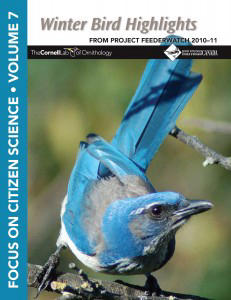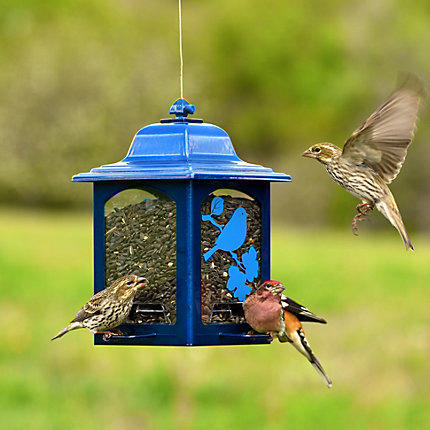
Each Project FeederWatch participant receives a copy of the “Winter Bird Highlights.”

Identify and count the birds at your feeders, water feature and yard for Project FeederWatch, such as these Purple Finches.
|
Project FeederWatch is a winter-long survey of birds that visit feeders across North America that takes your interest in feeding birds into regional and continental scientific discoveries. Participants periodically identify and count the birds they see at their feeders and send their information to Project FeederWatch. Your bird counts help you keep track of what is happening in your own backyard, but also help ornithologists track long-term trends in bird distribution and abundance. In that way your observations become part of something bigger.
Anyone interested in birds can participate, and Project FeederWatch participants include birders of all skill levels and backgrounds, including individuals, families, children, classrooms, youth groups, nature centers and birding clubs. You can count birds as often as every week, or as infrequently as you like – the schedule is completely flexible. All you need is a bird feeder, birdbath or plants that attract birds.
New participants are sent a Research Kit with complete instructions for participating, as well as a bird identification poster, calendar and more. You provide the feeder(s), seeds and tallies. Then each fall participants receive FeederWatch’s 16-page year-end report, Winter Bird Highlights, that will include your contributions. Participants also receive the digital version of Living Bird, the Cornell Lab’s award-winning quarterly magazine. Project FeederWatch is operated by the Cornell Lab or Ornithology and Bird Studies Canada.
For more information, and to join Project FeederWatch, see
https://feederwatch.org/about/project-overview/
When thousands of FeederWatchers in communities across North America identify and count birds visiting their feeding stations, and send their tallies to the FeederWatch database, the result is a treasure trove of numbers, which FeederWatch ornithologists analyze to provide insights into winter bird abundance and distribution.
Be sure to see how Project FeederWatch information gleaned from studying the information birders have provided about birds visiting their feeders at https://www.allaboutbirds.org/30-years-of-project-feederwatch-yield-new-insights-about-backyard-birds/
And just in case there is a dull moment at your feeding station, view the FeederWatch Cam in southern Ontario, along with the associated videos at http://cams.allaboutbirds.org/channel/38/FeederWatch_Cam/